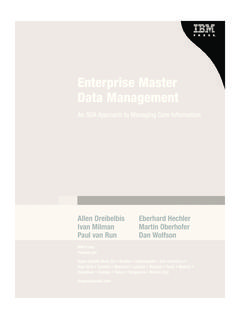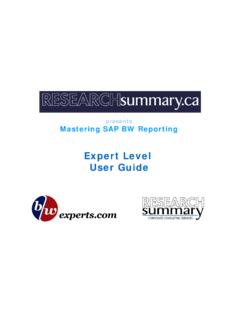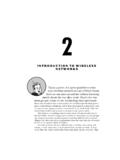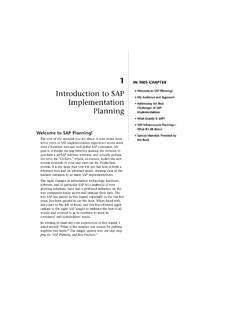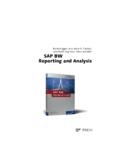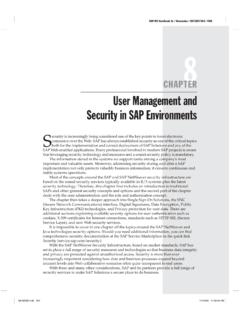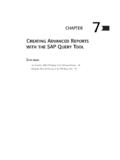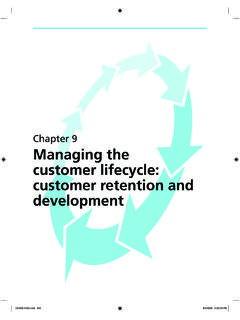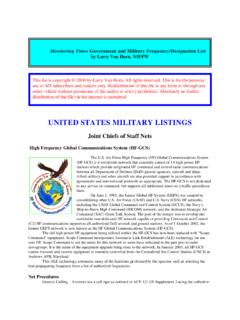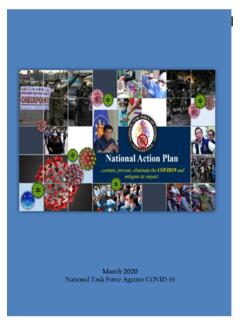Transcription of Guide to call center metrics - cdn.ttgtmedia.com
1 2008, Strategic contact , 10call centermetricsMetricAcronymDefinitionAppl icationTips about using this metricService levelSL or SVLP ercentage of calls (X%) answered with in Y seconds. Service level is generally measured for each time interval( , half hour) and oftenreported on a daily, weekly, ormonthly basis. Service level applies to a given queue, phone number, or group/skill set. Service level is generallyexpressed with notation such as 80/35 (for 80% in 35 seconds). Service levelis a common method for measuring the service to a particular queue or call type. It is one of the most important measures of customer experience. Service level is a key target metric to use for performance and workforce planning. A typical target would be 80% of all calls answered within 20 seconds (although there are no standards; each center must determine its target service levelbased on many factors, including business goals and budget).
2 Guide to call center metricsPresented by in partnership with Strategic contact 2008, Strategic contact , about using this metricQuality monitoring scoresQMNumerical scoring and notes/feedback about the service provided to customers. Quality monitoring scores are normally used in reference to call monitoring, using some sort of scorecard. However, it can actually be any quality measurement referring to calls, paperwork, web interactions or email. May be expressed asa numerical grade or percentage value. Most commonly used to determine individual call center agent performance, but is also used in aggregated scoring at the team, centerand enterprise levels. It s important to design monitoring and score sheets and elements that are as objective as possible. It s extremely important to provide feedback to the agentas soon as possible following observation.
3 Customer satisfactionCSATM easure of the overall satisfaction of the interaction or service. Customer satisfactionis an important measure of success and is vital method of feedback for process and product improvement. Companies that devote energy and resources into determining their customer satisfaction are more easily able to maintain a competitive position. Ideally, the customer satisfaction survey is focused on the call center /customer interaction (not overall products/services) and is tied to a contact . Customer satisfaction is customarily measured by a survey, either in-house or third-party. Common methods of surveyinginclude:oAutomated surveys (IVR) immediately after the calloTelephone surveys and call backsoCompany Web SiteoMailoEmail 2008, Strategic contact , about using this metricAdherenceN/ATotal time an agent is available for call work divided by the time they are scheduled expressed as a percentage.
4 Schedule adherence is used to ensure that agentswork the amount of timethey are supposed to work. Sometimes adherence can take into account the specific times an agenttakesbreaks andother time off the phone (often referred to as compliance ). Used in a high volume/large call center environments where CSR availability is not easily seen or monitored. It is a methodofmeasuring whether or not agentsare signed on for the required time. Workforce management systems may provide this information either expressed as a percentage, or also how many minutes (+,-) an agent was out of compliance with his or her schedule. Some flexibility is allowed to accommodate the unpredictability of call lengths. Some will differentiate adherence (amount of time) with compliance (specific times), the latter being more detailed and rigorous time tracking.
5 2008, Strategic contact , about using this metricOccupancy (also called utilization)OCCT otal handle time divided by total time signed into the queue expressed as a percent. Occupancy is the amount of time an agent spends either talking orinafter call work from handling a customer call . Since agentscannot control their own occupancy this metric is a big picture metric which provides a high level snap shot of how resources are being used. Inversely, it reflects how much time call center agentson average are waiting for a call . An 85% occupancy rate means that 15% of the agent stime is available and waiting for a call . Occupancy will be lower for smaller groups and higher for larger groups. If occupancy runs too high, too often, it can lead to burn out and turnover.
6 Occupancy is a key factor looked at in workforce management/planning. The workforce planner and managers/supervisors should be accountable for occupancy. Average handle timeAHTThe total amount of work time related to calls, including ATT and ACW, divided by the number of calls handled Average handle time is the total average amount of time an agentspends talking and in post call work in relation to a call . Comprised of average talk time (ATT)and average after- call work time (ACW). Average handle timeis a metric which can be monitored or measured at an agent, center or enterprise level. Similar to average talk time, average handle timecan be easily manipulated so caution is given to how this metric is monitored or measured. Aside from call volume and service level, it is the most critical metric in determining the workforce required.
7 2008, Strategic contact , about using this metricNumber of calls offeredNCOT otal number of calls offered to a queue. Calls or contacts offered to a queue are important metric to help quantify the amount of resources and staff needed to handle the queue. May be used in several ways:oThe total number of callers seeking service or contact (before reaching an IVR or recorded message)oThe total number of calls that were available to be answered by the queue (post IVR selection and recording) It is important to differentiate exactly when an organizationis counting a call as offered. This will vary from company to company. It can be measured at the network level, but is usually measured at the switch. Thus, blocked calls can be missed. 2008, Strategic contact , about using this metricForecast versus actual (calls)Forecast versus actual (average handle time)+,-FCST+,-FCSTE xpressed as a percentage of the difference between the amount of calls forecasted and the amount actually received.
8 +, -% above or below forecastExpressed as a +,-% above or below forecast Also expressed as a number +,-above or below forecast Accurately forecasting the amount of volume is critically important for call centers. It is a key element for determining the appropriate amount of resources required. ------------------------------------- Accurately forecasting the length of calls and contacts is the second most critical component for determining the appropriate amount of resources required Telephone distribution systems (ACDs) and workforce management systems (WFM) work in conjunction to provide comparisons of actual call and contact volumes received and staff required with what was forecasted and projected. High importance is placed on forecast accuracyas it directly drives the cost of laborand impacts the customer experience (proper forecast leads to proper staffing and good performance).
9 This metric is usually monitoredand measured at multiple levels interval, day, week, Anticipated handle time multiplied by the amount of calls that need to be handled determines the base work load requirement. Automatic call distributor systems track and report average talk time, after- call work time and total average handle time. 2008, Strategic contact , about using this metricCost per contactCPCT otal of all costs associated with answering a call or handling a contact divided by the total number of calls orcontacts. Cost per call / contact is a common metric used widely across all industries. Monitoring cost per call allows management to determine where to spend valuable funds on technology and process improvement. It is important to clearly identify which costs are included and not included in the resources like HR, IT, facilities included in your calculation?
10 OAre they determined on a pro-rated basis or are they straight costs? Usually monitored/measured as a specific period of time weekly, monthly, quarterly. Generally broken out by channel/media ( , self service via IVR, web; assisted service via phone, email, chat)Blocking rateN/APercent of calls offered that are not allowed into the system; generally % receiving busy, but may also include messages and forced disconnects. Blocking is an important metric to consider to ensure that you are allowing your customers access to your center . It is generally kept very low (under 1%). Blocking rate must be considered along with service level to ensure that the customer has access; you can meet service level but have a high blocking rate, and therefore dissatisfied customers.
